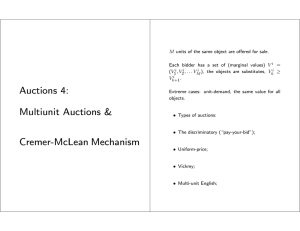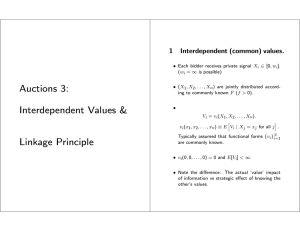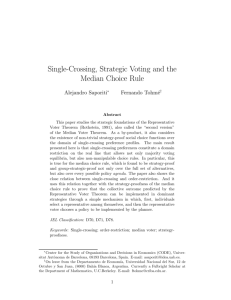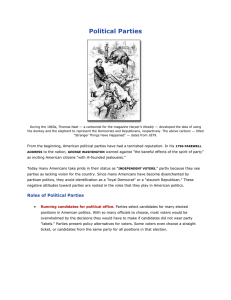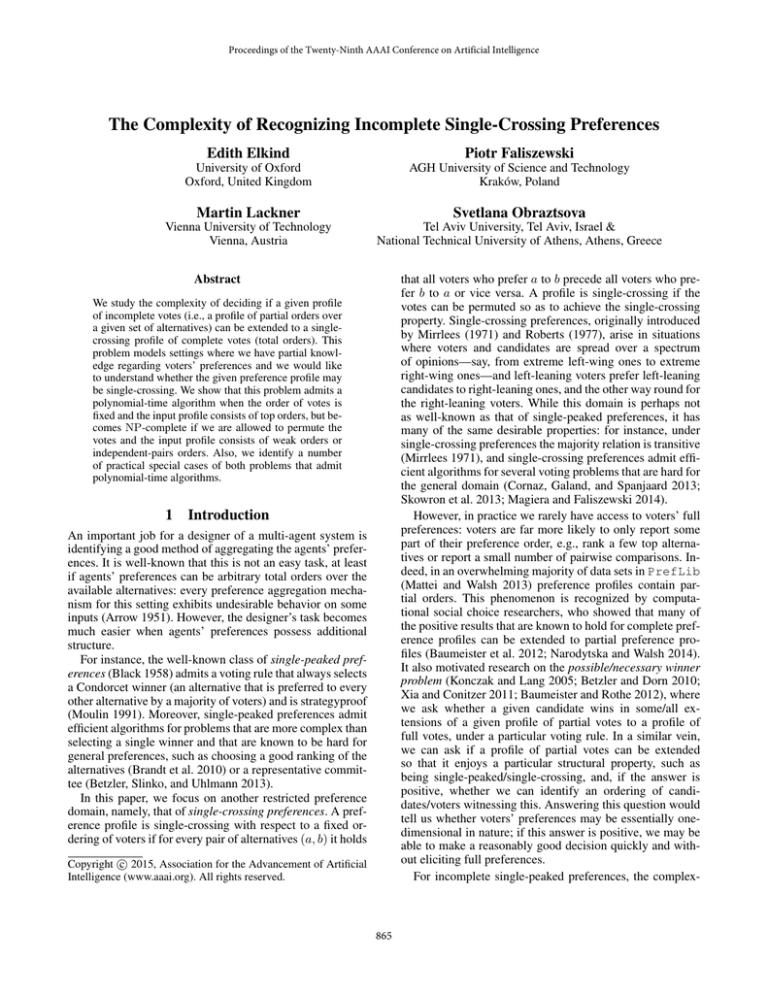
Proceedings of the Twenty-Ninth AAAI Conference on Artificial Intelligence
The Complexity of Recognizing Incomplete Single-Crossing Preferences
Edith Elkind
Piotr Faliszewski
University of Oxford
Oxford, United Kingdom
AGH University of Science and Technology
Kraków, Poland
Martin Lackner
Svetlana Obraztsova
Vienna University of Technology
Vienna, Austria
Tel Aviv University, Tel Aviv, Israel &
National Technical University of Athens, Athens, Greece
that all voters who prefer a to b precede all voters who prefer b to a or vice versa. A profile is single-crossing if the
votes can be permuted so as to achieve the single-crossing
property. Single-crossing preferences, originally introduced
by Mirrlees (1971) and Roberts (1977), arise in situations
where voters and candidates are spread over a spectrum
of opinions—say, from extreme left-wing ones to extreme
right-wing ones—and left-leaning voters prefer left-leaning
candidates to right-leaning ones, and the other way round for
the right-leaning voters. While this domain is perhaps not
as well-known as that of single-peaked preferences, it has
many of the same desirable properties: for instance, under
single-crossing preferences the majority relation is transitive
(Mirrlees 1971), and single-crossing preferences admit efficient algorithms for several voting problems that are hard for
the general domain (Cornaz, Galand, and Spanjaard 2013;
Skowron et al. 2013; Magiera and Faliszewski 2014).
However, in practice we rarely have access to voters’ full
preferences: voters are far more likely to only report some
part of their preference order, e.g., rank a few top alternatives or report a small number of pairwise comparisons. Indeed, in an overwhelming majority of data sets in PrefLib
(Mattei and Walsh 2013) preference profiles contain partial orders. This phenomenon is recognized by computational social choice researchers, who showed that many of
the positive results that are known to hold for complete preference profiles can be extended to partial preference profiles (Baumeister et al. 2012; Narodytska and Walsh 2014).
It also motivated research on the possible/necessary winner
problem (Konczak and Lang 2005; Betzler and Dorn 2010;
Xia and Conitzer 2011; Baumeister and Rothe 2012), where
we ask whether a given candidate wins in some/all extensions of a given profile of partial votes to a profile of
full votes, under a particular voting rule. In a similar vein,
we can ask if a profile of partial votes can be extended
so that it enjoys a particular structural property, such as
being single-peaked/single-crossing, and, if the answer is
positive, whether we can identify an ordering of candidates/voters witnessing this. Answering this question would
tell us whether voters’ preferences may be essentially onedimensional in nature; if this answer is positive, we may be
able to make a reasonably good decision quickly and without eliciting full preferences.
For incomplete single-peaked preferences, the complex-
Abstract
We study the complexity of deciding if a given profile
of incomplete votes (i.e., a profile of partial orders over
a given set of alternatives) can be extended to a singlecrossing profile of complete votes (total orders). This
problem models settings where we have partial knowledge regarding voters’ preferences and we would like
to understand whether the given preference profile may
be single-crossing. We show that this problem admits a
polynomial-time algorithm when the order of votes is
fixed and the input profile consists of top orders, but becomes NP-complete if we are allowed to permute the
votes and the input profile consists of weak orders or
independent-pairs orders. Also, we identify a number
of practical special cases of both problems that admit
polynomial-time algorithms.
1
Introduction
An important job for a designer of a multi-agent system is
identifying a good method of aggregating the agents’ preferences. It is well-known that this is not an easy task, at least
if agents’ preferences can be arbitrary total orders over the
available alternatives: every preference aggregation mechanism for this setting exhibits undesirable behavior on some
inputs (Arrow 1951). However, the designer’s task becomes
much easier when agents’ preferences possess additional
structure.
For instance, the well-known class of single-peaked preferences (Black 1958) admits a voting rule that always selects
a Condorcet winner (an alternative that is preferred to every
other alternative by a majority of voters) and is strategyproof
(Moulin 1991). Moreover, single-peaked preferences admit
efficient algorithms for problems that are more complex than
selecting a single winner and that are known to be hard for
general preferences, such as choosing a good ranking of the
alternatives (Brandt et al. 2010) or a representative committee (Betzler, Slinko, and Uhlmann 2013).
In this paper, we focus on another restricted preference
domain, namely, that of single-crossing preferences. A preference profile is single-crossing with respect to a fixed ordering of voters if for every pair of alternatives (a, b) it holds
c 2015, Association for the Advancement of Artificial
Copyright Intelligence (www.aaai.org). All rights reserved.
865
order witnessing that the election is single-crossing. Thus, if
we could find an order witnessing that a profile of top orders
can be extended to a single-crossing profile, then we could
use the algorithm of Skowron et al. (2013).
There is a further added benefit of considering the singlecrossing property in the context of partial preference orders. Intuitively, when voters cast partial preference orders,
they only specify pairwise comparisons that they truly care
about. Consequently, the resulting profiles are much more
likely to satisfy various structural properties (such as being single-peaked/single-crossing) than profiles where voters are forced to rank candidates that they do not care about
(and may therefore rank them in a way that hides the true
preference structure).
ity of this problem has been investigated by Lackner (2014),
who proved that it is NP-complete when the input may consist of arbitrary partial orders, and more recently by Fitzsimmons (2014), who showed it to be polynomial-time solvable for weak orders. The goal of our paper is to initiate
the complexity-theoretic investigation of this problem for incomplete single-crossing preferences.
Our Contribution. We consider the complexity of deciding whether a given profile of partial orders can be extended
to a profile of total orders that is single-crossing. We investigate this problem both for the setting where we are allowed
to permute the votes so as to achieve the single-crossing
property and for the setting where the desired ordering of
the votes is fixed.
We first focus on the case where the ordering of the votes
is provided as part of the input, and show that our problem
admits an efficient algorithm when the input profile consists
of top orders, or when no input vote contains an antichain of
size 3 and for every pair of candidates there is at least one
voter who is able to compare them. We then turn to the problem of checking whether a given profile of partial orders can
be extended to a profile of total orders that is single-crossing
with respect to some ordering of votes. We show that this
problem is NP-complete, even if all votes in the input are
weak orders, or if in each input vote all antichains of size 2
are pairwise disjoint. Given these hardness results, we focus
on top orders, and obtain polynomial-time algorithms under mild additional assumptions on voters’ preferences. We
show that, given a profile of top orders R, we can efficiently
decide whether it can be extended to a single-crossing profile of total orders if R contains at least one full vote and
(i) we seek an ordering of the votes where some such vote
appears first or (ii) the input profile is narcissistic, i.e., each
candidate is ranked first by at least one voter.
We also investigate alternative extensions of the singlecrossing property to the domain of partial votes. In particular, we define the notion of a weakly single-crossing profile,
and show that such profiles can be detected efficiently.
Related Work. Both single-peaked and single-crossing
preferences can be recognized in polynomial time if the input is a collection of total orders (Bartholdi and Trick 1986;
Escoffier, Lang, and Öztürk 2008; Elkind, Faliszewski, and
Slinko 2012; Bredereck, Chen, and Woeginger 2013b). The
problem becomes much more difficult if we ask whether a
given preference profile is close to being single-peaked or
single-crossing, or, more generally, close to belonging to
some restricted domain, for an appropriate notion of distance; indeed, many (though not all!) variants of this problem are known to be NP-hard (Erdélyi, Lackner, and Pfandler 2013; Bredereck, Chen, and Woeginger 2013a; Faliszewski, Hemaspaandra, and Hemaspaandra 2014). Both
single-peaked and single-crossing preferences arise in societies that are, in some sense, one-dimensional; however, the
two notions are distinct, in the sense that there are singlepeaked elections that are not single-crossing and vice versa
(Mirrlees 1971); see also the work of Elkind et al. (2014).
2
Preliminaries
For each integer k, we denote the set {1, . . . , k} by [k]. Let
C be a finite set of candidates (alternatives). A (strict) partial order is a binary relation over C that has the following
properties: for every a, b, c ∈ C (i) a 6 a; (ii) a b implies
b 6 a; (iii) a b and b c implies a c. We say that
a pair of alternatives a, b is comparable in if a b or
b a; otherwise we say that a and b are incomparable in
and write a ⊥ b. A partial order is said to be total if
a b or b a for every a, b ∈ C. A total order is an extension of a partial order 0 if for every pair of alternatives
a, b such that a 0 b it holds that a b.
When a b, we say that ranks a above b. For readability, we will often denote a generic partial order by r and
write a r b or r : a b when r ranks a above b.
A partial order is said to be a weak order if for all
a, b, c ∈ C it holds that a ⊥ b and b ⊥ c implies a ⊥ c.
Equivalently, in a weak order all candidates are partitioned into several equivalence classes C1 , . . . , Ck so that
for a ∈ Ci , b ∈ Cj we have a ⊥ b if i = j and a b if
i < j. Weak orders can be understood as total orders with
ties allowed. A top order is a weak order where |C1 | = · · · =
|Ck−1 | = 1. Intuitively, top orders correspond to a voter
ranking some of her most preferred alternatives, and leaving
the remaining alternatives unranked. Thus, we refer to the
Relevance of Our Study. We believe that understanding
the single-crossing property in the context of partial preference orders is important in its own right. However, our research also has a more direct motivation: knowing that a profile of partial preference orders can be extended to a singlecrossing one can simplify the winner determination process,
both in single-winner and in multi-winner elections.
Consider a profile of top orders in a single-winner election. If we know that the votes can be extended to a singlecrossing profile for a given voter order, then we can find the
median vote in this order and pick its top candidate as the
winner. This candidate is a possible Condorcet winner and,
thus, a natural one to select.
For the case of multi-winner elections, Skowron et
al. (2013) have shown an efficient winner determination algorithm for the voting rule of Chamberlin and
Courant (1983), for the case of single-crossing elections (in
the general setting, the rule is NP-hard (Procaccia, Rosenschein, and Zohar 2008; Lu and Boutilier 2011)). Their algorithm focuses on the top parts of the votes, but requires the
866
Sk−1
candidates in i=1 Ci as the ranked candidates.
0
A set C ⊆ C is said to be an antichain in if a ⊥ b
for all a, b ∈ C 0 . A partial order is said to be an independent pairs order if all antichains of size 2 in are pairwise
disjoint (this implies that has no antichains of size 3).
Single-Crossing Property. A list R = (r1 , . . . , rn ) of
(partial) orders is called a (partial) profile. We refer to elements of [n] as voters: the order ri is the vote of voter i.
Definition 1. A profile R = (r1 , . . . , rn ) of total orders over
a candidate set C is said to be single-crossing with respect to
a total order @ on [n] if for every pair of candidates a, b ∈ C
such that the first voter in @ prefers a to b it holds that the
voters who prefer a to b precede in @ the voters who prefer
b to a. A profile R = (r1 , . . . , rn ) of total orders is said to
be single-crossing if there exists a total order @ on [n] such
that R is single-crossing with respect to @.
Definition 2. A profile R = (r1 , . . . , rn ) of partial orders
over a candidate set C is said to be single-crossing with
b=
respect to a total order @ on [n] if there exists a profile R
(b
r1 , . . . , rbn ) of total orders, where rbi is an extension of ri
for each i ∈ [n], that is single-crossing with respect to @. R
is said to be single-crossing if there exists a total order @ on
[n] such that R is single-crossing with respect to @.
Computational Problems. The goal of this paper is to
study the computational complexity of the following two
problems (and their special cases):
interval each voter either prefers b to a or indicates that
a and b are incomparable. A profile R = (r1 , . . . , rn ) of
partial orders is seemingly single-crossing if it is seemingly
single-crossing with respect to some total order @ over [n].
A profile of total orders is single-crossing if and only if
it is seemingly single-crossing. One might expect that the
same is true for profiles of partial orders, i.e., that a profile of
partial orders that is seemingly single-crossing with respect
to some order of votes @ can be extended to a profile of total
orders that is single-crossing with respect to @. However,
the next example shows that this is not the case.
Example 1. Let C = {a, b, c} and consider the following
profile R = (r1 , r2 , r3 , r4 ) of partial orders:
r1 : a b c,
r3 : b a,
r4 : a c.
It is easy to see that R is seemingly single-crossing with
respect to the order 1 @ 2 @ 3 @ 4. However, R cannot
be extended to a profile of total orders (b
r1 , rb2 , rb3 , rb4 ) that is
single-crossing with respect to @. Indeed, a r1 b, b r3 a
implies that rb4 would have to rank b above a, and b r1
c, c r2 b means that rb4 would have to rank c above b.
By transitivity, it follows that rb4 ranks c above a, but this is
impossible, since a r4 c.
This argument does not show that R is not singlecrossing. In fact, R is single-crossing with respect to a different order of voters, namely 1 @0 2 @0 4 @0 3, as witnessed by the following profile (b
r1 , rb2 , rb3 , rb4 ) of total orders
(for convenience, the votes below are listed according to @0 ):
PARTIAL O RDER S INGLE -C ROSSING C ONSISTENCY
— F IXED O RDER (PO-SCC-F):
Given a candidate set C, a profile R = (r1 , . . . , rn ) of
partial orders over C, and a total order @ on [n], decide
whether R is single-crossing with respect to @.
rb1 : a b c,
rb4 : a c b,
rb2 : a c b,
rb3 : c b a.
However, we can modify R so that it remains seemingly
single-crossing, but is not single-crossing with respect to any
order of voters. Specifically, set C 0 = {a, b, c, d, e, f }, and
consider the following profile R0 = (r10 , r20 , r30 , r40 ) of partial
orders over C 0 , which is obtained by prepending a singlecrossing profile of total orders over {d, e, f } to R:
PARTIAL O RDER S INGLE -C ROSSING C ONSISTENCY
(PO-SCC):
Given a candidate set C and a profile R = (r1 , . . . , rn )
of partial orders over C, decide whether R is singlecrossing.
We are also interested in special cases of PO-SCC-F and
PO-SCC where the input profile contains: (i) weak orders
only (WO-SCC-F/WO-SCC), (ii) top orders only (TOSCC-F/TO-SCC), (iii) independent-pairs orders only (IPSCC-F/IP-SCC).
We omit some proofs due to space constraints. The omitted proofs appear in the full version of the paper.
3
r2 : c b,
r10 : d e f a b c,
r20 : e d f,
f a,
f c b,
r30 : e f d,
d c,
d b a,
r40 : f e d,
d b,
d a c.
It is easy to see that R0 is seemingly single-crossing with respect to 1 @ 2 @ 3 @ 4. Further, the {d, e, f }-parts of orders
in R0 ensure that the only orders for which R0 is seemingly
single-crossing are 1 @ 2 @ 3 @ 4 and 4 @ 3 @ 2 @ 1.
Thus, no extension of R is single-crossing.
Fixed Order of Votes
Before we move to the computational results, let us illustrate how counterintuitively partial orders can behave with
respect to the single-crossing property. Let us define a relaxed variant of this property, tailored to partial orders.
Definition 3. A profile R = (r1 , . . . , rn ) of partial orders
over a candidate set C is seemingly single-crossing with respect to a total order @ over [n] if for every pair of candidates a, b ∈ C the voters can be divided into two (possibly
empty) consecutive intervals with respect to @ so that (i) in
one of these intervals each voter either prefers a to b or indicates that a and b are incomparable, and (ii) in the other
Example 1 shows that, to solve PO-SCC-F, it is not sufficient to check whether the input profile is seemingly singlecrossing. Indeed, we have been unable to determine the complexity of PO-SCC-F for unrestricted inputs. However, we
can show that this problem becomes polynomial-time solvable if we additionally assume that no order in the input profile contains an antichain of size 3, and no pair of candidates
is incomparable in every vote.
867
set S = R0 , and therefore this profile, which we will denote
b = (b
by R
r1 , rb2 , . . . , rbn ), is an extension of R. We claim that
b
R is single-crossing with respect to @.
b is not single-crossing and let ` be the
Suppose that R
largest index such that (b
r1 , . . . , rb`−1 ) is single-crossing.
Thus, (b
r1 , . . . , rb` ) is not single-crossing and there exists a
pair a, b of candidates such that
rb1 : a b,
rb`−1 : b a,
rb` : a b.
Candidates a and b are ranked differently in rb`−1 and rb` ,
so Algorithm E could not have derived the ranking a b
in rb` from rb`−1 . Hence, in r` we also have a b. Since
rb1 and rb`−1 rank a and b differently and given how vote
rb1 is computed, there must be a k, 1 ≤ k < ` − 1 such
that rk : a b and neither a nor b are ranked in any ri ,
i ∈ [k − 1]. Consequently, the triple (rk , r`−1 , r` ) witnesses
that R is not seemingly single-crossing with respect to 1 @
2 @ · · · @ n, a contradiction with our assumption. Thus, the
algorithm outputs a single-crossing extension of R.
Theorem 2. One can determine whether an n-voter mcandidate profile of partial orders R is single-crossing with
respect to a given order @ on [n] in O m2 · n · (m + n)
time under the following two conditions: (1) R does not contain a vote with an antichain of size 3, and (2) no pair of
candidates is incomparable in every vote.
If a profile does not satisfy conditions (1) and (2) in the
statement of Theorem 2, but there are only few antichains of
size 3 and “fully” incomparable candidate pairs, we can still
solve this problem efficiently. Let a denote the total number
of antichains of size 3 in R and let b denote the number of
candidate pairs that are incomparable in all votes.
Corollary 3. The PO-SCC-F
problem can be solved in
O 2a+b · m2 · n · (m + n) time.
For top orders, a stronger result is true: TO-SCC-F is
polynomial-time solvable with no additional constraints on
the input profile. Moreover, for top orders the phenomenon
illustrated in Example 1 does not arise: every seemingly
single-crossing profile of top orders is single-crossing. To
prove this, we will now present an algorithm that, given a
profile R of top orders that is seemingly single-crossing with
respect to an ordering @, explicitly constructs an extension
of R that is single-crossing with respect to @. We first describe a subroutine E used by our algorithm.
4
Arbitrary Order of Voters
We will now consider the scenario where the ordering of
the votes is not given in the input, and we have to decide
whether the given profile is single-crossing with respect to
some ordering of the votes. Note that in this setting we can
assume that all votes in the input profile R are pairwise distinct, as we can simply remove all duplicates without changing the answer. Therefore, we can view R as a set of votes,
and identify a voter i with her vote ri . In particular, it will
sometimes be convenient to write ri @ rj in place of i @ j.
Hardness Results The problem PO-SCC turns out to be
NP-complete. To show this, we will provide a reduction
from the B ETWEENNESS problem, defined below, which is
known to be NP-complete (Opatrny 1979).
B ETWEENNESS:
Given a set S = {s1 , . . . , sm } and a set T of triples
over S, decide whether there exists a total order < over
S such that for each triple (si , sj , sk ) in T it holds that
either si < sj < sk or sk < sj < si .
To reduce B ETWEENNESS to PO-SCC, we use instances
of the following gadget. Let R = (r1 , r2 , r3 ) be a profile
over C = {a, b, c} such that: r1 : a b c, r2 : b a c,
and r3 : c b a. It is easy to verify that R is singlecrossing with respect to exactly two orders: 1 @ 2 @ 3 and
its reverse.
Theorem 5. PO-SCC is NP-complete.
Algorithm E : The algorithm takes as input a profile R =
(r1 , . . . , rn ) of top orders, where r1 is a total order, and an
order @ over [n] such that 1 @ i for each i ∈ {2, . . . , n}.
It computes a profile of total orders as follows:
1. It orders the votes in R according to @ to obtain a profile S = (s1 , . . . , sn ); note that r1 = s1 .
2. It sets sb1 = s1 and for each i ∈ {2, . . . , n} (in the
ascending order), it extends si to sbi by ranking all the
unranked candidates as in sbi−1 (note that by the time it
processes si , sbi−1 is a total order).
3. It returns (b
s1 , . . . , sbn ).
Theorem 4. There is a polynomial-time algorithm that
given a profile R of top orders that is seemingly singlecrossing with respect to an order @ on [n], outputs an extension of R that is single-crossing.
Proof. Let C be a set of candidates and let R = (r1 , . . . , rn )
be a profile of top orders over C that is seemingly singlecrossing with respect to an order @ on [n]. Without loss of
generality, we assume that @ is given by 1 @ 2 @ · · · @ n.
b = (b
To find a single-crossing extension R
r1 , . . . , rbn ) of R,
we first compute an extension rb1 of r1 :
Proof. Clearly, this problem is in NP. To show that is is
NP-hard, we provide a reduction from B ETWEENNESS.
Let I = (S, T ) be an instance of B ETWEENNESS, where
S = (s1 , . . . , sm ) and T = (t1 , . . . , tn ) is a set of triples
over S. The idea of our proof is to form a profile where the
voters correspond to the elements of the set S and the constraints from the set T are implemented within the partial
orders using the gadget described just before the theorem
statement. We let D = A∪B ∪C, where A = {a1 , . . . , an },
B = {b1 , . . . , bn }, and C = {c1 , . . . , cn }, and form a partial
profile R = (r1 , . . . , rm ) over D as follows:
1. Set rb1 = r1 .
2. For each i = 2, . . . , n, if ri ranks some candidates that rb1
does not yet rank, append these candidates to rb1 (in order
of their appearance in ri ).
3. If rb1 still does not rank all the candidates, append them to
rb1 in an arbitrary order.
Now we have a profile R0 = (b
r1 , r2 , . . . , rn ) of top orders, where rb1 is a total order. We run Algorithm E on R0 to
obtain a profile of total orders. Note that in Algorithm E we
868
1. For each ` ∈ [m], each i, j ∈ [n], i < j, each x ∈
{ai , bi , ci } and each y ∈ {aj , bj , cj }, we set r` : x y.
2. For each triple t` = (si , sj , sk ) ∈ T , we set:
Theorem 8. There is a polynomial-time algorithm that
given an instance I = (C, R) of TO-SCC, where R =
(r1 , . . . , rn ), and an index ` such that r` is a total order, decides if there is an order @ such that: (i) for each k, k 6= `,
r` @ rk , and (ii) R is single-crossing with respect to @.
ri : a` b` c` , rj : b` a` c` , rk : c` b` a` .
Proof. Without loss of generality, we can assume that ` = 1.
Our algorithm consists of two parts. First, in Algorithm L,
we compute an order @ witnessing that R is seemingly
single-crossing (if indeed it is), and then we invoke Algorithm E to compute an appropriate extension of R. If Algorithm L fails at any point, we reject the input (if we reach
Algorithm E, failure is impossible).
By the theorem’s assumptions, the first element in @, r1 ,
is a total order. We define a relation @∗ over {r2 , . . . , rn }
as follows: For each i, j, 2 ≤ i, j ≤ n, if there is a pair of
candidates a, b ∈ C such that r1 and ri order a, b identically
but rj orders them differently, we set ri @∗ rj . Algorithm L
is given below:
3. For each ` ∈ [m] every pair of candidates not mentioned
in the previous two points are incomparable in r` .
We claim that R is single-crossing if and only if I is a
“yes”-instance of B ETWEENNESS. First, assume that R is
single-crossing with respect to some order @. By construction, for each triple t` = (si , sj , sk ) ∈ T , we have either
ri @ rj @ rk or rk @ rj @ ri . This means that an order <
over S such that sx < sy if and only if rx @ ry witnesses
that I is a “yes”-instance of the B ETWEENNESS problem.
On the other hand, assume that I is a “yes”-instance of
the B ETWEENNESS problem and that some order < over S
witnesses this. We define an order @ over {r1 , . . . , rm } so
that rx @ ry if and only if sx < sy . To show that R is
single-crossing with respect to @, we will now extend R to
a profile of total orders as follows. Consider a triple t` =
(si , sj , sk ) ∈ T . W.l.o.g., assume that si < sj < sk (the
case sk < sj < si can be handled in a similar way). We
define the voters’ preferences regarding a` , b` , c` as follows:
Algorithm L : We compute the relation @∗ over
{r2 , . . . , rn } and extend it to relation @∗∗ over R
as follows: for each pair i, j ∈ [n] we set ri @∗∗ rj if
either i = 1 or ri @∗ rj . Using the standard algorithm for
topological sorting, we check if @∗∗ can be extended to a
linear order. If so, we compute and return this order (this
will be our order @). If not, we reject.
1. For each rx such that rx @ ri , set rx : a` b` c` .
2. For each ry (y 6= j) such that ri @ ry @ rk , set ry : b` a` c` .
3. For each rz such that rk @ rz , set rz : c` b` a` .
It is immediate that if this algorithm rejects then R is not
single-crossing with respect to any order @ that places r1
first. We claim that if it does not reject, then the profile R is
seemingly single-crossing with respect to the order @ computed by L. If it were not, then there would be two candidates a and b and two integers k and `, 1 < k, ` ≤ n, k 6= n,
such that r1 @ rk @ r` and a r1 b, b rk a, and a r` b.
However, by definition of @∗ , we would have r` @∗ rk , contradicting the fact that Algorithm L did not reject. Thus, R is
seemingly single-crossing with respect to @. Now, by Theorem 4, we can invoke Algorithm E with R and @ as input to
get a single-crossing extension of R.
After this operation, the profile consists of total orders, and
it is clear that it is single-crossing with respect to @.
The partial orders in the profile from the proof of Theorem 5 are, in fact, weak orders. Thus, we get the next result.
Corollary 6. WO-SCC is NP-complete.
Moreover, we can adapt our proof of Theorem 5 to show
that IP-SCC is NP-complete as well.
Let u-TO-SCC be the special case of the TO-SCC problem where each vote has at most u unranked candidates. As
we can guess the leftmost vote in @ (n options) and its extensions (u! options), we obtain the following corollary.
Corollary 9. The u-TO-SCC problem can be solved in
O(2u·log u · poly(m, n)) time.
For our next result, we need to assume that our profile of
top orders is narcissistic, i.e., every candidate is ranked first
by at least one voter; this assumption dates back to the work
of Bartholdi and Trick (1986), and has been used in several
recent computational social choice papers (Cornaz, Galand,
and Spanjaard 2012; Skowron et al. 2013); we expect it to
be satisfied when candidates are allowed to vote in the election. For such profiles, we can relax the condition of Theorem 8: we still require that at least one voter submits a total
order, but make no assumptions about this voter’s position in
the profile. We remark that one can assume that the profile
contains a total order if, e.g., the person who wants to understand if the given election is single-crossing is herself a voter
Theorem 7. IP-SCC problem is NP-complete.
Top Orders The case of top orders is by far the most important and practical one. It turns out that it is also quite challenging: we have not been able to determine the exact complexity of TO-SCC. Nonetheless, we will now describe several polynomial-time algorithms for this problem that work
under additional mild constraints on voters’ preferences.
The first of these algorithms (Theorem 8) applies in a situation where we know the complete order of one of the two
extreme voters in the profile; alternatively, we could imagine that we define this “extreme” voter ourselves and add it
to the profile that we have at hand. In essence, this means
that for this algorithm to be applicable, we need to know for
every pair of candidates a and b which one of them is closer
to a given extreme side of the opinions in the single-crossing
spectrum. In practice, in settings where we have a good understanding of the nature of the candidates, we should expect
to have the necessary information to use this algorithm.
869
k < i < ` candidates a and b are incomparable in ri , and
for all ` ≤ i ≤ n we have b ri a, or, alternatively, (ii) for
all 1 ≤ i ≤ k we have b ri a, for all k < i < ` candidates
a and b are incomparable in ri , and for all ` ≤ i ≤ n we
have a ri b. A profile R = (r1 , . . . , rn ) of partial orders
is weakly single-crossing if it is weakly single-crossing with
respect to some total order @ over [n].
in this election; this assumption is also required for some of
the algorithmic results of Lackner (2014), and is known to
reduce vote elicitation complexity (Conitzer 2009).
Theorem 10. There is a polynomial-time algorithm that
given an instance I = (C, R) of the T OP PARTIAL O R DER SCC problem, where R = (r1 , . . . , rn ) is narcissistic
and contains at least one total order, decides if R is singlecrossing.
Observe that partial profile R from Example 1 is not
weakly single-crossing with respect to 1 @ 2 @ 3 @ 4:
we go from a c to a ⊥ c to a c. Consequently, the
profile R0 from that example is not weakly single-crossing.
Clearly, it is easy to check if a given partial profile R
is weakly single-crossing with respect to a given order @.
Interestingly, while checking whether R is weakly singlecrossing appears to be more difficult, this problem turns out
to be polynomial-time solvable as well.
Independent-Pairs Orders: an Algorithm We can adapt
the algorithm from the proof of Theorem 8 to obtain a fixedparameter tractability result for IP-SCC. Let k-IP-SCC be
the special case of IP-SCC where each vote contains at most
k incomparable pairs of candidates.
Theorem 11. There is an algorithm that decides k-IP-SCC
in time O(2k · poly(m, n)).
5
Theorem 13. There is a polynomial-time algorithm that
given a partial profile R checks whether R is weakly singlecrossing, and, if the answer is positive, outputs an ordering
of the voters that witnesses this.
Relaxing the Single-Crossing Condition
Throughout this paper, we implicitly assumed that voters’
true preferences are total orders, and the reasons why voters submit partial orders have to do with computation and/or
communication constraints. Alternatively, one can imagine
that some voters are truly indifferent between certain candidates. It is not clear whether requiring the given profile of
partial orders to extend to a single-crossing profile of total
orders is the right generalization of the single-crossing condition to such settings. In fact, one can argue that in case
of true indifferences seemingly single-crossing profiles are
exactly the partial profiles that should be considered singlecrossing: indeed, in such profiles no pair of alternatives can
be observed to cross more than once. If we view being seemingly single-crossing as a desirable property of a partial profile in its own right, it is natural to ask whether it can be
detected efficiently. However, this question turns out to be
computationally difficult, even if we restrict ourselves to
weak orders or independent-pairs orders.
6
Conclusions and Open Problems
We summarize our results for SCC and SCC-F in Table 1. It
is instructive to compare them with recent results of Lackner (2014) and Fitzsimmons (2014) for single-peaked preferences. Lackner proves that one can check in polynomial
time whether a profile of partial votes is single-peaked with
respect to a given axis. In contrast, verifying the singlecrossing property appears to be hard even if the order of
the votes is fixed, though we have not been able to obtain
a formal hardness result. Moreover, powerful algorithmic
techniques that are very useful for working with incomplete
single-peaked preferences, such as reductions to 2-S AT and
to the consecutive ones problem, while applicable, appear to
produce much weaker results in our setting. These are indications that incomplete single-crossing preferences are more
difficult to work with than incomplete single-peaked preferences, and new insights are required.
The computational complexity of some of our problems
remains open. Perhaps the most intriguing is the complexity
of TO-SCC (top orders, arbitrary order of votes) and WOSCC-F (weak orders, fixed order of votes). Also, given that
much of the real-life election data consists of incomplete
Proposition 12. The problem of deciding if a profile of weak
orders is seemingly single-crossing is NP-complete. Also,
the problem of deciding if a profile of independent-pairs orders is seemingly single-crossing is NP-complete.
Proposition 12 follows from Corollary 6 and Theorem 7,
respectively, by observing that the partial profiles constructed in the respective proofs are single-crossing if and
only if they are seemingly single-crossing.
Now, in a seemingly single-crossing profile, as we
progress from left to right, for a given pair of candidates
a, b we may go from a voter who is indifferent between a
and b to one who clearly prefers a to b and then to one who
is indifferent between a and b again. It is perhaps more intuitive to require instead that the only allowable transitions are
from a b to indifference between a and b to b a, or vice
versa. We will call such profiles weakly single-crossing.
PO
WO
TO
IP
Definition 4. A profile R = (r1 , . . . , rn ) of partial orders
over a candidate set C is weakly single-crossing with respect to a total order @ over [n] if for every pair of candidates a, b ∈ C there exist indices 0 ≤ k ≤ ` ≤ n + 1 such
that either (i) for all 1 ≤ i ≤ k we have a ri b, for all
SCC-F
SCC
FPT(a, b) (Cor. 3)
FPT(a, b) (Cor. 3)
NPc (Thm. 5)
NPc (Cor. 6)
special cases (Thms. 8 and 10),
FPT(u) (Cor. 9)
NPc (Thm. 7),
FPT(k) (Thm. 11)
P (Thm. 4)
FPT(a, b) (Cor. 3)
Table 1: Complexity results: P stands for “polynomial-time
solvable”, NPc stands for “NP-complete”, FPT stands for
“fixed-parameter tractable”
870
Cornaz, D.; Galand, L.; and Spanjaard, O. 2012. Bounded
single-peaked width and proportional representation. In
ECAI-12, 270–275.
Cornaz, D.; Galand, L.; and Spanjaard, O. 2013. Kemeny
elections with bounded single-peaked or single-crossing
width. In IJCAI-13, 76–82.
Elkind, E.; Faliszewski, P.; and Skowron, P. 2014. A characterization of the single-peaked single-crossing domain. In
AAAI-14, 654–660.
Elkind, E.; Faliszewski, P.; and Slinko, A. 2012. Clone
structures in voters’ preferences. In EC-12, 496–513.
Erdélyi, G.; Lackner, M.; and Pfandler, A. 2013. Computational aspects of nearly single-peaked electorates. In AAAI13, 283–289.
Escoffier, B.; Lang, J.; and Öztürk, M. 2008. Single-peaked
consistency and its complexity. In ECAI-08, 366–370.
Faliszewski, P.; Hemaspaandra, E.; and Hemaspaandra, L.
2014. The complexity of manipulative attacks in nearly
single-peaked electorates. Artificial Intelligence 207:69–99.
Fitzsimmons, Z. 2014. Single-peaked consistency for weak
orders is easy. Technical Report arXiv:1406.4289 [cs.GT],
arXiv.org.
Konczak, K., and Lang, J. 2005. Voting procedures with
incomplete preferences. In Proceedings of the Multidisciplinary IJCAI-05 Worshop on Advances in Preference Handling, 124–129.
Lackner, M. 2014. Incomplete preferences in single-peaked
electorates. In AAAI-14, 742–748.
Lu, T., and Boutilier, C. 2011. Budgeted social choice: From
consensus to personalized decision making. In IJCAI-11,
280–286.
Magiera, K., and Faliszewski, P. 2014. How hard is control
in single-crossing elections? In ECAI-14, 579–584.
Mattei, N., and Walsh, T. 2013. Preflib: A library for preferences. In ADT-13, 259–270.
Mirrlees, J. 1971. An exploration in the theory of optimal
income taxation. Review of Economic Studies 38:175–208.
Moulin, H. 1991. Axioms of Cooperative Decision Making.
Cambridge University Press.
Narodytska, N., and Walsh, T. 2014. The computational
impact of partial votes on strategic voting. In ECAI-14, 657–
662.
Opatrny, J. 1979. Total ordering problem. SIAM Journal on
Computing 8(1):111–114.
Procaccia, A.; Rosenschein, J.; and Zohar, A. 2008. On the
complexity of achieving proportional representation. Social
Choice and Welfare 30(3):353–362.
Roberts, K. W. S. 1977. Voting over income tax schedules.
Journal of Public Economics 8(3):329–340.
Skowron, P.; Yu, L.; Faliszewski, P.; and Elkind, E. 2013.
The complexity of fully proportional representation for
single-crossing electorates. In SAGT-13, 1–12.
Xia, L., and Conitzer, V. 2011. Determining possible and
necessary winners given partial orders. Journal of Artificial
Intelligence Research 41:25–67.
preference orders, it would be interesting to check often reallife elections admit single-crossing extensions.
Acknowledgements. Piotr Faliszewski was supported in
part by NCN grants DEC-2012/06/M/ST1/00358, DEC2011/03/B/ST6/01393, and by AGH University grant
11.11.230.124 (statutory research). Martin Lackner was supported by the Austrian Science Fund (FWF): P25518-N23
and by the Vienna Science and Technology Fund (WWTF)
project ICT12-15. Svetlana Obraztsova was supported by
European Union (European Social Fund — ESF) and Greek
national funds through the Operational Program “Education and Lifelong Learning” of the National Strategic Reference Framework (NSRF) — Research Funding Program:
THALES, by RFFI 14-01-00156-a grant, and by a STSM
grant from the COST Action IC120.
References
Arrow, K. 1951. Social Choice and Individual Values. John
Wiley and Sons.
Bartholdi, III, J., and Trick, M. 1986. Stable matching with
preferences derived from a psychological model. Operations
Research Letters 5(4):165–169.
Baumeister, D., and Rothe, J. 2012. Taking the final step
to a full dichotomy of the possible winner problem in pure
scoring rules. Information Processing Letters 112(5):186–
190.
Baumeister, D.; Faliszewski, P.; Lang, J.; and Rothe, J. 2012.
Campaigns for lazy voters: Truncated ballots. In AAMAS12, 577–584.
Betzler, N., and Dorn, B. 2010. Towards a dichotomy of
finding possible winners in elections based on scoring rules.
Journal of Computer and System Sciences 76(8):812–836.
Betzler, N.; Slinko, A.; and Uhlmann, J. 2013. On the computation of fully proportional representation. Journal of Artificial Intelligence Research 47:475–519.
Black, D. 1958. The Theory of Committees and Elections.
Cambridge University Press.
Brandt, F.; Brill, M.; Hemaspaandra, E.; and Hemaspaandra,
L. 2010. Bypassing combinatorial protections: Polynomialtime algorithms for single-peaked electorates. In AAAI-10,
715–722.
Bredereck, R.; Chen, J.; and Woeginger, G. 2013a. Are
there any nicely structured preference profiles nearby? In
IJCAI-13, 62–68.
Bredereck, R.; Chen, J.; and Woeginger, G. 2013b. A characterization of the single-crossing domain. Social Choice
and Welfare 41(4):989–998.
Chamberlin, B., and Courant, P. 1983. Representative deliberations and representative decisions: Proportional representation and the Borda rule. American Political Science
Review 77(3):718–733.
Conitzer, V. 2009. Eliciting single-peaked preferences using comparison queries. Journal of Artificial Intelligence
Research 35:161–191.
871

